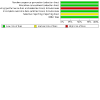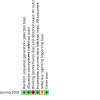Garlic for the common cold
- PMID: 25386977
- PMCID: PMC6465033
- DOI: 10.1002/14651858.CD006206.pub4
Garlic for the common cold
Abstract
Background Garlic is alleged to have antimicrobial and antiviral properties that relieve the common cold, among other beneficial effects. There is widespread usage of garlic supplements. The common cold is associated with significant morbidity and economic consequences. On average, children have six to eight colds per year and adults have two to four.Objectives To determine whether garlic (Allium sativum) is effective for the prevention or treatment of the common cold, when compared to placebo, no treatment or other treatments.Search methods We searched CENTRAL (2014, Issue 7),OLDMEDLINE (1950 to 1965),MEDLINE (January 1966 to July week 5, 2014), EMBASE(1974 to August 2014) and AMED (1985 to August 2014).Selection criteria Randomised controlled trials of common cold prevention and treatment comparing garlic with placebo, no treatment or standard treatment.Data collection and analysis Two review authors independently reviewed and selected trials from searches, assessed and rated study quality and extracted relevant data.Main results In this updated review, we identified eight trials as potentially relevant from our searches. Again, only one trial met the inclusion criteria.This trial randomly assigned 146 participants to either a garlic supplement (with 180 mg of allicin content) or a placebo (once daily)for 12 weeks. The trial reported 24 occurrences of the common cold in the garlic intervention group compared with 65 in the placebo group (P value < 0.001), resulting in fewer days of illness in the garlic group compared with the placebo group (111 versus 366). The number of days to recovery from an occurrence of the common cold was similar in both groups (4.63 versus 5.63). Only one trial met the inclusion criteria, therefore limited conclusions can be drawn. The trial relied on self reported episodes of the common cold but was of reasonable quality in terms of randomisation and allocation concealment. Adverse effects included rash and odour. Authors' conclusions There is insufficient clinical trial evidence regarding the effects of garlic in preventing or treating the common cold. A single trial suggested that garlic may prevent occurrences of the common cold but more studies are needed to validate this finding. Claims of effectiveness appear to rely largely on poor-quality evidence.
Conflict of interest statement
Elizabeth Lissiman: none known. Alice Bhasale: support was received for professional development to learn Cochrane methodology, but not to conduct this particular review. Marc Cohen: none known.
Figures
Update of
-
Garlic for the common cold.Cochrane Database Syst Rev. 2012 Mar 14;(3):CD006206. doi: 10.1002/14651858.CD006206.pub3. Cochrane Database Syst Rev. 2012. Update in: Cochrane Database Syst Rev. 2014 Nov 11;(11):CD006206. doi: 10.1002/14651858.CD006206.pub4. PMID: 22419312 Updated.
References
References to studies included in this review
Josling 2001 {published data only}
-
- Josling P. Preventing the common cold with a garlic supplement: a double-blind, placebo-controlled survey. Advances in Therapy 2001;18(4):189-93. - PubMed
References to studies excluded from this review
Andrianova 2003 {published data only}
-
- Andrianova IV, Sobenin IA, Sereda EV, Borodina LI, Studenikin MI. Effect of long-acting garlic tablets "Allicor" on the incidence of acute respiratory viral infections in children. Terapevticheskii Arkhiv 2003;75(3):53-6. - PubMed
Hiltunen 2007 {published data only}
Nantz 2012 {published data only}
-
- Nantz MP, Rowe CA, Muller CE, Creasy RA, Stanilka JM, Percival SS. Supplementation with aged garlic extract improves both NK and γδ-T cell function and reduces the severity of cold and flu symptoms: a randomized, double-blind, placebo-controlled nutrition intervention. Clinical Nutrition 2012;31(3):337-44. - PubMed
Polanco‐Rojas 2013 {published data only}
-
- Polanco-Rojas AD, Burgos-Arias AN. Qualitative study of the effect on consumption of the mother tincture of Allium sativum (garlic) in the lysozyme concentration and total protein in children under 6 years old with acute respiratory infection in the Hualqui Medic's office, VIII Region of Chile. Latinoamericano y del Caribe de Plantas Medicinales y Aromáticas 2013;12(3):294-301.
Rafinski 1974 {published data only}
-
- Rafinski T, Alkiewicz J, Wrocinski T, Jezowa L. Clinical studies on the use of garlic extract Alliofil in pediatrics. Polski Tygodnik Lekarski 1974;29(37):1595-7. - PubMed
Ushirotake 2004 {published data only}
-
- Ushirotake T, Ushirotake A, Suzuki M, Shimizu A, Shiratori T, Uematsu K et al. Epidemiological investigation for common cold preventive effect of Kyoleopin and Leopin Five. Clinical Drug and Pharmacology 2004;20(7):785-93.
Additional references
AHRQ 2000
-
- Agency for Healthcare Research and Quality. Garlic: effects on cardiovascular risks and disease, protective effects against cancer, and clinical adverse effects. Evidence report/technology assessment: Number 20. In: AHRQ Publication No. 01-E022 (http://www.ahrq.gov/clinic/epcsums/garlicsum.htm). Rockville, MD: Agency for Healthcare Research and Quality, 2000 (accessed 6 June 2006).
Ankri 1999
-
- Ankri S, Mirelman D. Antimicrobial properties of allicin from garlic. Microbes and Infection 1999;1:125-9. - PubMed
Barnes 2004
-
- Barnes PM, Powell-Griner E, McFann K, Nahin RL. Complementary and alternative medicine use among adults: United States, 2002. Advance Data 2004;343:1-19. - PubMed
Cavallito 1944
-
- Cavallito CJ, Bailey JH. Allicin, the antibacterial principle of allium sativum. I. isolation, physical properties and antibacterial action. Journal of the American Chemical Society 1944;66:1950-1. - PubMed
Fendrick 2003
-
- Fendrick AM, Monto AS, Nightengale B, Sarnes M. The economic burden of non-influenza-related viral respiratory tract infection in the United States. Archives of Internal Medicine 2003;163:487-94. - PubMed
Fugh‐Berman 2000
-
- Fugh-Berman A. Herb-drug interactions. Lancet 2000;355:134-8. - PubMed
Harris 2000
-
- Harris P, Rees R. The prevalence of complementary and alternative medicine use among the general population: a systematic review of the literature. Complementary Therapies in Medicine 2000;8:88-96. - PubMed
Hemilä 2013
Higgins 2011
-
- Higgins JPT, Green S (editors). Cochrane Handbook for Systematic Reviews of Interventions Version 5.1.0 [updated March 2011]. The Cochrane Collaboration, 2011. Available from www.cochrane-handbook.org.
Karsch‐Völk 2014
Kyo 2001
-
- Kyo E, Uda N, Kasuga S, Itakura Y. Immunomodulatory effects of aged garlic extract. Journal of Nutrition 2001;131(Suppl 3):1075-9. - PubMed
Lawson 2001
-
- Lawson LD, Wang ZJ, Papadimitriou D. Allicin release under simulated gastrointestinal conditions from garlic powder tablets employed in clinical trials on serum cholesterol. Planta Medica 2001;67(1):13-8. - PubMed
MacLennan 2006
-
- MacLennan A, Myers S, Taylor A. The continuing use of complementary and alternative medicine in South Australia: costs and beliefs in 2004. Medical Journal of Australia 2006;184:27-31. - PubMed
Miller 2000
-
- Miller LG, Hume A, Harris IM, Jackson EA, Kanmaz TJ, Cauffield JS et al. White paper on herbal products. Pharmacotherapy 2000;20(7):877-91. - PubMed
Naganawa 1996
NCCAM 2006
-
- National Center for Complementary and Alternative Medicine. Garlic: herbs at a glance. http://nccam.nih.gov/health/garlic/ 2006 (accessed 7 June 2006).
RevMan 2014 [Computer program]
-
- Review Manager (RevMan). Version 5.3. Copenhagen: The Nordic Cochrane Centre, The Cochrane Collaboration, 2014.
Rivlin 2001
-
- Rivlin RS. Historical perspective on the use of garlic. Journal of Nutrition 2001;131(Suppl 3):951-4. - PubMed
Ruddock 2005
-
- Ruddock PS, Liao M, Foster BC, Lawson L, Arnason JT, Dillon JA et al. Garlic natural health products exhibit variable constituent levels and antimicrobial activity against Neisseria gonorrhoeae, Staphylococcus aureus and Enterococcus faecalis. Phytotherapy Research 2005;19:327-34. - PubMed
Silagy 1994
-
- Silagy CA, Neil HA. A meta-analysis of the effect of garlic on blood pressure. Journal of Hypertension 1994;12:463-8. - PubMed
Singh 2013
Staba 2001
-
- Staba EJ, Lash L, Staba JE. A commentary on the effects of garlic extraction and formulation on product composition. Journal of Nutrition 2001;131(Suppl 3):1118-9. - PubMed
Tapsell 2006
-
- Tapsell LC, Hemphill I, Cobiac L, Patch CS, Sullivan DR, Fenech M et al. Health benefits of herbs and spices: the past, the present, the future. Medical Journal of Australia 2006;185(Suppl 4):4-24. - PubMed
Weber 1992
-
- Weber ND, Anderson DO, North JA, Murray BK, Lawson LD, Hughes BG. In vitro virucidal effects of Allium sativum (garlic) extract and compounds. Planta Medica 1992;58(5):417-23. - PubMed
WHO 1999
-
- World Health Organization and International Conference of Drug Regulatory Authorities. WHO Monographs on Selected Medicinal Plants. World Health Organization, 1999.
Zhang 2008
-
- Zhang AL, Story DF, Lin V, Vitetta L, Xue CC. A population survey on the use of 24 common medicinal herbs in Australia. Pharmacoepidemiology and Drug Safety 2008;17:1006-13. - PubMed
References to other published versions of this review
Lissiman 2009
Publication types
MeSH terms
Substances
LinkOut - more resources
Full Text Sources
Other Literature Sources
Medical
Miscellaneous



